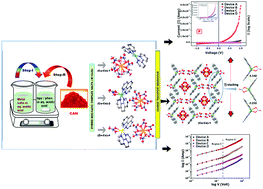De novo synthesis of hybrid d–f block metal complex salts for electronic charge transport applications†‡
Abstract
The advent of d–d type complex salts for designing smart functional materials with versatile utility inspired us to develop a novel type of M(II)–Ce(IV) complex salts [M(II) = Cu and Zn ions]. In this study, we present for the first time a holistic approach to design and prepare metal complex salts of the novel hybrid d–f block type, [Cu(bpy)2]2[Ce(NO3)6]2 (1), [Cu(phen)2(NO3)]2[Ce(NO3)6](HNO3) (2), [Zn(bpy)2(NO3)][ClO4] (3), and [Zn(phen)2(NO3)]2 [Ce(NO3)6] (4); [bpy = 2,2′-bipyridine; phen = 1,10-phenanthroline]. The intrinsic structural and morphological properties of the compounds have been revealed by employing a suite of analytical and spectroscopic methods. X-ray structural analysis reveals that the copper(II) centres in the cationic complex units of 1 and 2 adopt a highly distorted tetrahedral and a rare bicapped square pyramidal coordination geometry, respectively. The zinc(II) ions in both 3 and 4 adopt the rare bicapped square pyramidal geometry while the cerium(IV) ions in 1, 2 and 4 exist in a dodecahedral geometry. Investigation of supramolecular interactions reveals that intermolecular O⋯H and O⋯π short contacts bind the complex units in 1, while predominant π⋯π interactions, along with O⋯H and O⋯π short contacts, produce the binding force among the complex units in 2. We further employed the complex salts (1–4) to construct Schottky devices to reveal the role of these new complex salts in the charge-transport phenomenon. The carrier mobilities (μ) for salts 1–4 were determined to be 1.76 × 10−6, 9.02 × 10−6, 1.86 × 10−8, and 4.31 × 10−8 m2 V−1 s−1, with respective transit times (τ) of 439, 85, 4.17 × 103, and 1.79 × 103 ns, which suggest that complex salt 2 is the best candidate with the highest transport properties among all the complex salts. A crystal engineering perspective sheds light on the charge-transport properties of the complex salts, emphasizing the attribution of the best performance of 2 to its predominant π⋯π interactions. The synthesis of this new type of complex salts, their physicochemical properties and their charge-transport applications envisage great promise for the development of novel crystalline materials with smart functionalities.



 Please wait while we load your content...
Please wait while we load your content...